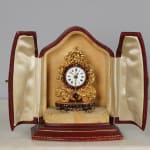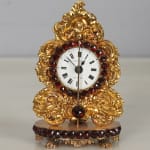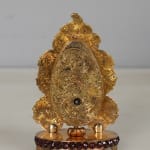Josef Jessner
Further images
Provenance
From a private collection, Switzerland.
An early 19th Century gilt bronze miniature "Zappler" carriage clock, signed on the white enamel dial Jessner in Wien. Decorated with acanthus volutes, shell motifs rocailles. In the original red marrocain leather case.
Vienna, date circa 1820
Height of the clock 6.4 cm
Viennese Zapplers are miniature clocks whose name derives from their rapidly swinging front pendulum. They are a speciality of the 19th century in which the focus is not on the accuracy of the rate but on the walkability and a successful case design despite the en miniature scale. The material chosen was usually fire-gilt bronze, much more rarely silver or gold. Sometimes the cases were mounted on ebonised bases and fitted with glass lintels, in some cases they even had a matching case. Zapplers were already extremely popular collectors' items in the Biedermeier era. Travellers liked to bring back such a clock as a souvenir from their stay in Vienna, as the city's clockmakers enjoyed a world-wide reputation.





